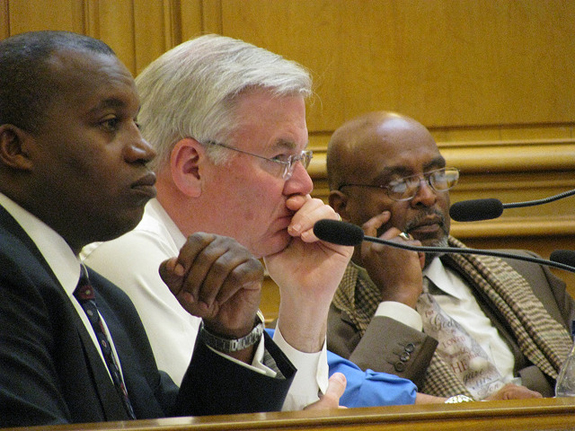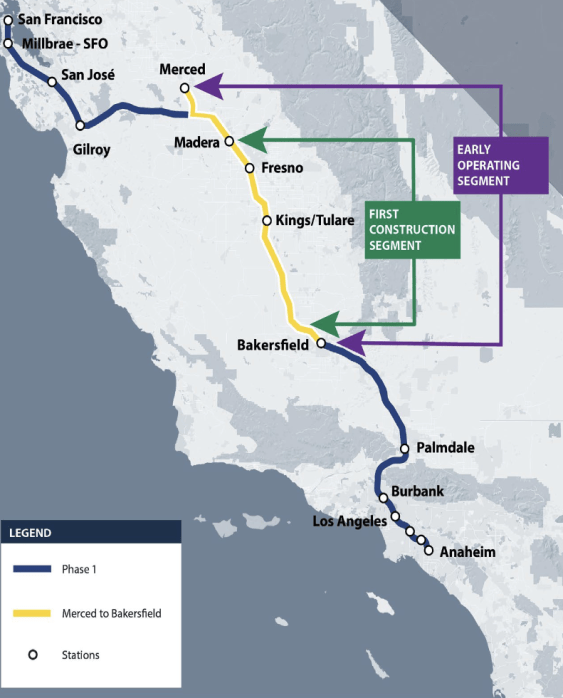Cameron Beach and Jerry Lee’s Future as SFMTA Board Members Uncertain
1:10 PM PST on March 4, 2011
Cameron Beach likes to mention that he started his career in public transportation forty six years ago sweeping buses. The 62-year-old semi-retired transportation consultant and former chief operating officer of the Sacramento Regional Transit District does know a lot about running a transit system.
However, as Beach's four-year term on the SFMTA Board of Directors comes to a close, there is uncertainty about whether he will be reappointed and City Hall sources told Streetsblog the Mayor's Office is accepting resumes from other candidates.
Director Jerry Lee's term also expired March 1, and like Beach, his future on the board is an open question. Beach and Lee have told the Mayor's Office they're interested in being reappointed, but neither has received an affirmative response yet. Each is allowed to attend board meetings until May as part of a 60 day grace period.
The Mayor's Press Office hasn't answered our questions yet about where the appointments stand, but Mayor Ed Lee told Streetsblog last week: “I think they’ve been at the helm of good policy and so I want to make sure we move forward on everything. Whether that means us changing out or not I can’t say at this time, but I’ll definitely be talking with each of them."
Although many transit advocates did not want to talk on the record about Beach and Lee, past criticism of board members has been that they have not been diligent enough finding new funding sources for Muni, they generally rubber stamp recommendations from staff, rarely offer their own proposals and often take orders from Room 200, instead of being a truly independent body as they were originally envisioned.
City Hall sources told Streetsblog there also has been some concern about the way Beach has been handling labor negotiations in closed-door sessions. Although no one we contacted would speak on the record because of the sensitivity of the negotiations, that could be one issue holding back Beach's nomination.
With two new board members seated in the last six months -- Cheryl Brinkman and Leona Bridges -- the thinking among some advocates and City Hall insiders is that the seats up for reappointment present an opportunity to nominate new blood, and place another person from the advocacy community on the board. One transit advocate, however, praised Beach and said he deserves to be reappointed.
"Beach really knows transit operations, and is the only MTA commissioner with such qualifications. MTA desperately needs folks with transportation expertise, and I hope that Mayor Lee will reappoint him," said Tom Radulovich, a BART Board member who is also the executive director of Livable City.
One notable Streetsblog story about Beach from December 2009 summarized how he grilled SFMTA staff about the slow light-rail speeds in the Twin Peaks tunnel. Beach said he still hasn't gotten answers. "I don’t want to embarrass staff in front of the board but I tell you, I am getting closer," he said.
Lee, a management training professional for United Parcel Service, did not initially respond to Streetsblog's request for an interview, but we caught him on the steps of City Hall this morning where he said he wants to continue working to improve Muni's reliability and safety.
"I vote my conscience and I was born and raised in the city and I do care about the city and the people that ride the Muni," he said.
Beach agreed to a lengthy interview earlier this week. Here are some excerpts from the interview, conducted Wednesday:
On his accomplishments and why he wants to be reappointed: I have always viewed issues from the user’s point of view. How is the passenger or the motorist or the person looking for a parking place or the bicyclist or the pedestrian going to perceive our action? One of the dictums I had learned in the transit industry many years ago from somebody far more cynical than I was: if the maintenance department likes it, chances are the passengers probably won’t. I have tried to look at this. I understand the issues of running a maintenance department. I understand the issues of running a transportation, or as Muni calls it, operations department, but I always tried to make decisions, when I was a staff guy as well as a board member, from the point of view of the user. And the user is not only the person that rides our buses or streetcars, but the motorist that shares the road with them or the bicycle. I ride a bike. I certainly walk a lot in the city. I just think that those are very important things for a board member to consider. Now I had a different perspective because I had worked in the business for a long time. Some of the other things that I think I have accomplished on the board is heightened awareness of senior and disability issues. I was the head of operations in Sacramento during the implementation of the Americans with Disabilities Act. There is certainly a very active senior and disabled community in San Francisco.
MTA now carries excess liability insurance. That is something they have never had before. It was something I was very surprised as a board member that we didn’t have. And the argument was the city will take care of it. Well, that to me is just not a prudent use of funds. That is not how you manage a business, whether it is a government entity or certainly not as a private entity; you wouldn’t ever survive that. So that was something that I fought for and we do now carry a level of excess liability insurance. I questioned the use of sole source contracts. I have voted to approve some, I have voted against some, but I think they need to be evaluated on their own merit. I did what I thought was due diligence in reviewing them and like I said, I approved some, I voted for the sole source contract to repair the Breda cars because nobody else could do it, but I didn’t vote for the sole source contract with Cubic for the fare collection rehab.
I have met with the executive director on a monthly basis to go over issues. In my role as a board member I don’t go to the staff and talk about this needs to be done or that needs to be done. That goes to the ED. That is a function of being a board member. In that process I have been asked by the ED to review and comment on operational issues on several occasions and I like to think that is a result of my experience in the business and my rapport with him. I have met with employees. The board members have gone out to the operating divisions and met with operators. I have met with maintenance staff. I think it is important to hear what our employees have to say. I ride the system regularly. I live in West Portal, a block off the K and the M lines, so I ride the streetcars to and from downtown all the time, but I ride all over the city on the system, kind of like I did when I was a kid. I have a beautiful car in the garage. I have a 2007 Mercedes and it is great when I go out of town on road trips, but it is pretty senseless to drive it anywhere in San Francisco. Parking is hard to come by and it is just not a good use of the resource.
On finding new revenue for Muni: I guess what I would like to do is kind of start with a clean slate and look at what revenues we need. I would also like, at the same time, to take another look at our expenses. This is one of the most expensive transit systems to operate in the world. Yes, it has got five different modes and that certainly adds to the expense, but I really think we need to try and rationalize the system. I was on the TEP review committee and I think the TEP was a great start. It identified a lot of things that we could be doing better. I realize now we are talking about expenses versus revenue or optimization of the system versus revenue, but I think that is where we need to look. I will be honest with you, there were changes in the TEP that I wasn’t comfortable with and I appear to be a minority because they have not generated that many issues in terms of complaints. Abandoning the 26 Valencia I thought would be a nightmare and yes, it has not been without problems, but it has certainly not been the outrage that I would have expected. But on your issue of new revenues, I served on the new revenue committee that Mayor Newsom put together several years ago right after I got on the board. I think this was about three years ago now, when I think about it. There is no silver bullet here. We need to almost start with a clean slate, decide what we can operate reliably, which has always been our nightmare. I live in probably the best part of the city for transit services. I walk a block and a half to a stop where there are two lines that run on about an eight minute base headway and have a trip to downtown that should take between 15 and 20 minutes. And every day when I go up there I don’t know if it is going to be a 20 minute trip or a 40 minute trip. Consistency and reliability are huge and they are the biggest issue that we seem to wrestle with. When I was in Sacramento as the head of operations I remember one day we had, you know, Murphy’s Law is you only break down just before the afternoon rush hour begins and I remember being at a station, 300 or 400 people on a platform, and I apologized to a group of people. I said ‘I am really sorry about this’. It was an incident where the overhead wire came down. It was not like somebody else caused an accident that we were a victim of. And a guy turned to me and he said ‘You know, I appreciate you saying that but you need to realize that 99 times out of 100 this train is here on time every day and we appreciate that’. It made me feel wonderful.
On carrying out former Mayor Gavin Newsom's executive directive on pedestrian safety: One of the other non-profit boards that I serve on is called California Operation Lifesaver, and it is an organization dedicated to minimizing or actually eliminating, railway grade crossing accidents and railroad trespassing. The three cornerstones of our mission are engineering, education and enforcement. From my point of view, it is the same thing with pedestrians. I look at the good things we have done with countdown clocks on a lot of pedestrian signals that weren’t there before and are also, by the way, an advantage to motorists, who are not as tempted to run a red light. Engineering-wise we have done some novel things with crosswalks. Unfortunately I think there are other cities that have done even more. Daly City out in the Westlake area has got some great pedestrian crossings with strobe lights which guarantee, as a motorist, to get your attention. The third piece to that is enforcement. When I look at the number of jaywalkers that we have in the city, it is one thing to jaywalk when I look up and down the street and there is no car for two blocks. It is another thing to jaywalk with impunity across a red light because I can. I just think we need to look at all three of those, but in a lot of cases, especially towards enforcement. I have only seen one pedestrian sting in recent years where we actually went after pedestrians who were violating the law. Like any bicyclist, it is funny, when I ride my bike I ride out to Lake Merced quite a bit, right out Ocean Avenue. I actually stop at the stop signs and the best part is watching the motorists’ reaction. ‘What the hell are you doing? You are supposed to roll through the stop sign.’ No, not me.
Thoughts on making drivers pay the true costs of driving, if you consider the externalities: Most motorists consider the cost of driving to be gasoline and parking, maybe maintenance and if you are really enlightened, maybe even insurance. But then you get into, as you point out, all of the other true externalities like streets, like parking, like parking garages, like congestion, like air pollution. I would argue that 95 percent of motorists, even in San Francisco, don’t adequately consider that. I think that is part of a story we need to tell. Everybody says instead of 30 percent on transit it should be 70 percent on transit and 30 percent on automobiles. That is a great idea but first off, Muni doesn’t have the money or the resources to deal with that. We carry almost 800,000 people a day. Imagine more than doubling that number. Should there be a more appropriate mix or a better balance? Absolutely, but I am not a transit Nazi, for lack of a better term. I think there has to be a proper mix of all the modes.
How often do you ride a bicycle? Not enough. Probably a couple of times a week, mainly for exercise.
Do you support Connecting the City, the San Francisco Bicycle Coalition's vision for crosstown bikeways? Yes, I do. It is interesting. We almost have come full circle because up until the late 1970s Muni had a terrible time trying to run crosstown routes. I grew up at Baker and Greenwich in Cow Hollow. In order to go out to the Richmond District I had to ride a bus to Steiner and Union, ride the 22 Fillmore over to Sutter or over to Geary and ride a bus out Geary or a bus out McAllister. Today I can get on a 28 line bus in that same neighborhood in Cow Hollow, ride through Presidio and be in the Richmond district in 20 minutes, not an hour and 15 minutes. So it makes sense that travel patterns have changed from a radial one to much more of a modified grid. Having crosstown bike lanes would be very supportive of that. We have done it with the transit system. Let’s open it up to other modes.
Stay in touch
Sign up for our free newsletter





